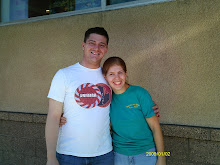
On a nature walk through the picturesque hills of Dongtan's Central Park, I stumbled upon the high fence that marked the edge of its trees. A trail ran invitingly along this borderland and, though I could have turned back downhill, I adventurously decided to follow. The view wasn't as beautiful as being submerged in greenery would have been, but it allowed me a chance to study the cityscape and decipher my current location. I picked out two subway lines and a gigantic church building as I observed. The subway trains I knew to be from Seoul's Line 1; the church I recognized from the time I rode to the subway stop in Dongtan. "There's Seodongtan [Station] right there," I told the trees, pointing behind the church. Instantly, I could orient myself in the suburban geography. My decision then was to continue onward along the fence.
As I made my decent, the fence soon broke off from the trail and in its place crawled a neat, asphalt drive. The trail soon ended in a small overgrown meadow and I decided to follow the road to the base of the hill: It would presumably lead to another road, which in turn would lead to still more roads and the way back to Central Park. As I approached the mouth of the drive, I

noticed the unkempt condition of the crossing street, its edges ragged zig-zags and its surface a tired grey. I considered each direction for the best way forward. As the subway station rested somewhere to my right, I decided I would walk left into town.
The thing that I noticed almost instantly as I began my hitch-hike back to town was the numbers on the sides of brick-and-concrete-posts lining the way: "Byeongjeomjungang-ro 22beon-gil," read one. It was an actual street, this worn-out strip of asphalt. What lined it then were addresses, skeletal remains of once-dignified lives. Concrete fences outlined what were once courtyards; roofs gaped open towards the sky. Artifacts of humanity lay exposed to the elements like the bones of a forgotten era: Mirrors, tapestries, hinges, and light fixtures mingled with plant life as if they had been grown there. "Jennifer's descending into the slums of Dongtan," I thought, looking around at the sagging scene in front of me.

As I continued my steady pace, I hoped that no one lived in these structures anymore. They were death-traps, glorified shanties. Glass-less windows made it possible to see from the back of one apartment building clear to the other side of the street and to another set of apartments. It was like the building wasn't even standing there! The area began to feel eerie and uncomfortable as I trekked through it, silent but for the chirp of summer cicadas. I was sure I was the only living soul on the street. I walked for what felt like a quarter-mile without seeing a crossing street or another person. "I just have to get out of here," I told myself to quicken my pace.
In my passage through the area, I saw only three other people: a welder in a small shop amid the debris, a businessman getting out of his car, and a younger man watering flowers at a nearby church. This church looked state-of-the-art, a beautiful structure three stories tall with shiny new windows, a trim parking lot, and a courtyard just inside its doors. I wondered at its age, as it looked recently-built. I marveled that

such a brand-new structure existed in such a run-down part of town. I wasn't sure how populated the church's immediate vicinity was, though I saw a car parked in front of one of the ruins that I passed. Fields adjacent to the street looked tended and plots of land, planted; surely someone must be living there. If the church were ministering to the needs of the surrounding local people, surely it would need to be a little more down-to-earth than this in such a district. It was an oddity among oddities, to be sure.
Touted as a "planned community," and extremely young at just three years old, one would think that Dongtan would be immune to such blemishes as the structures witnessed today. And yet, its hidden ruins speak of an age that belies its youthful radiance. New buildings are continually being raised and months-old businesses close their doors to be replaced by still-newer ventures. Yet just on the other side of the latest office-tels and storefronts lies the still portrait of another Dongtan, one whose wrinkle in time cannot be reclaimed to make something fresh or new. It stands as somber witness, a changeless birthmark on Dongtan's ever-changing landscape.


No comments:
Post a Comment